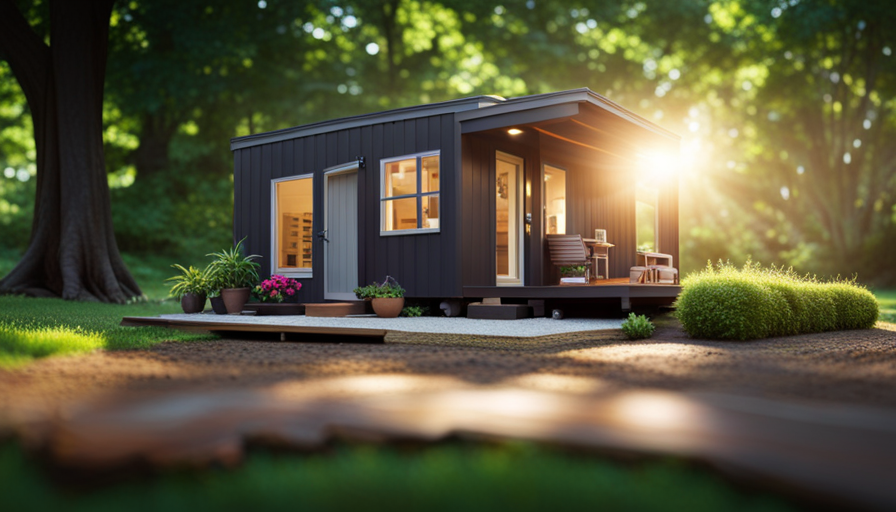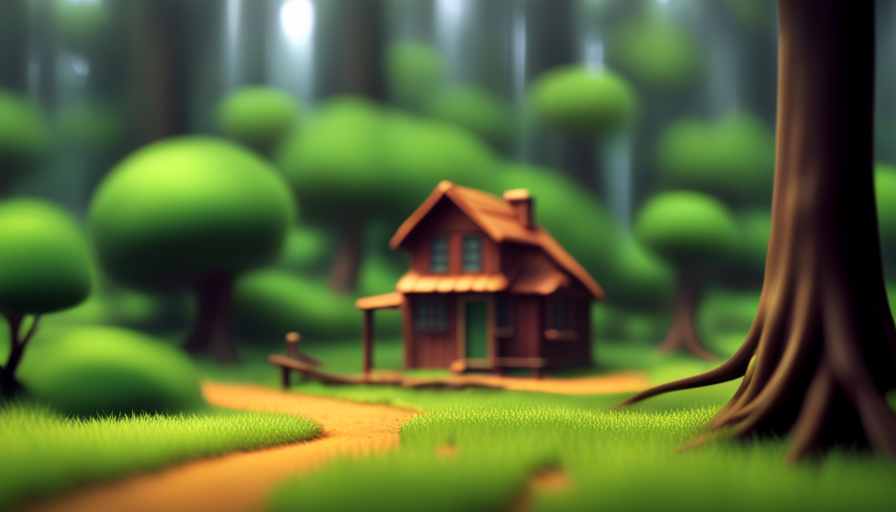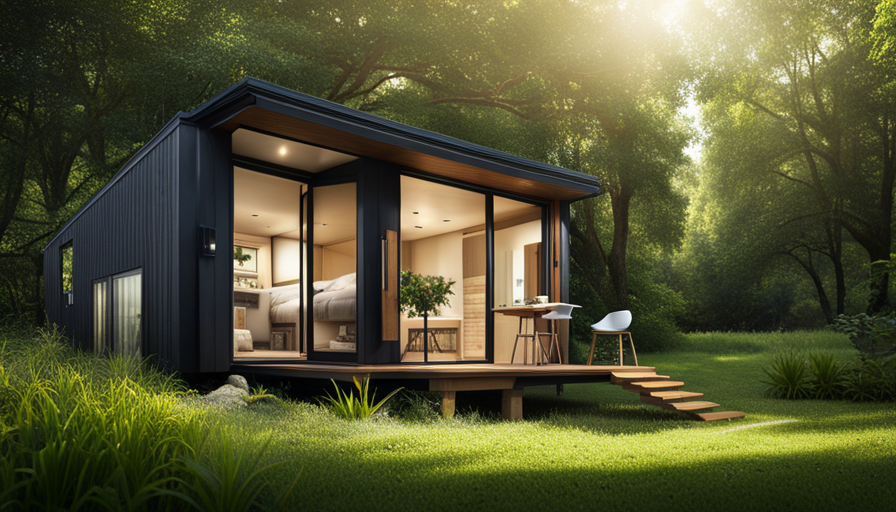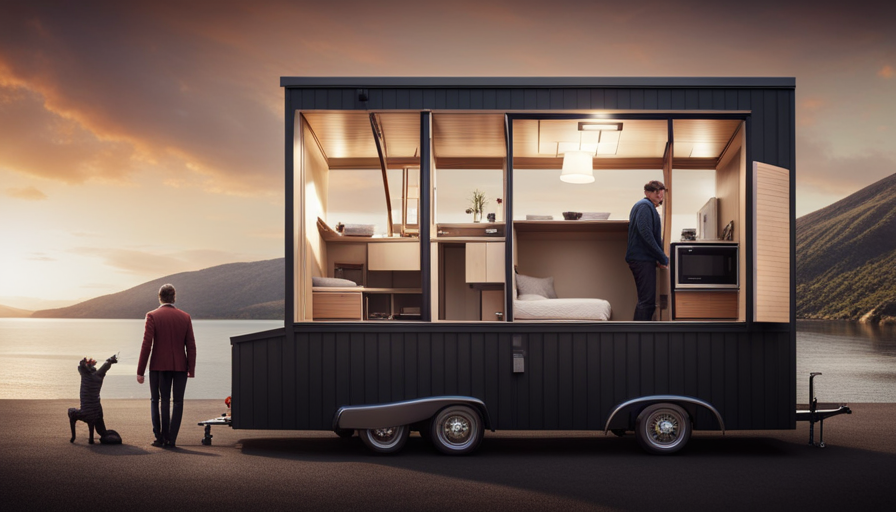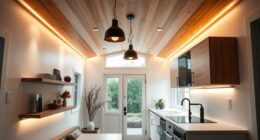Imagine a place where you can have a cozy, affordable home, like a small sanctuary in the middle of the city bustle. That’s exactly what you get with a 400 sq ft prefabricated tiny house – a compact but comfortable living space that won’t break the bank.
Like a well-crafted puzzle, these tiny houses fit together perfectly, offering a unique and efficient living experience. In this article, I’ll delve into the factors that affect the cost of a 400 sq ft prefabricated tiny house, comparing it to traditional housing options. I’ll also provide tips on how to keep the cost affordable and shed light on hidden expenses.
Moreover, I’ll present real-life case studies of 400 sq ft tiny houses and their associated costs. And finally, I’ll discuss financing options to help make your dream of owning a 400 sq ft prefabricated tiny house a reality.
So, let’s dive in and discover just how affordable and amazing these little gems can be!
Key Takeaways
- Factors affecting the cost of a 400 sq ft prefabricated tiny house include the layout, design, storage solutions, construction materials, and methods.
- Cost-effective options for building a tiny house include using modular construction and recycled materials.
- The average cost range for a 400 sq ft prefabricated tiny house is $50,000 to $100,000, but factors such as location, customization options, and finishes can influence the cost.
- Financing options for tiny houses include personal loans, RV loans, and loans specifically for tiny houses.
Factors Affecting the Cost of a 400 Sq Ft Tiny House
You’ll be surprised at how many factors can influence the cost of your 400 sq ft prefabricated tiny house. When it comes to maximizing storage space, the layout and design of your tiny house play a crucial role.
Clever storage solutions such as built-in cabinets, hidden compartments, and multi-functional furniture can significantly impact the cost. Additionally, the choice of construction materials and methods can make a big difference in the overall expenses.
Opting for cost-effective construction methods like modular construction or using recycled materials can help keep the costs down. However, it’s important to strike a balance between cost-effectiveness and quality, as compromising on the structural integrity of your tiny house can lead to costly repairs in the long run.
With careful planning and consideration of these factors, you can create a 400 sq ft prefabricated tiny house that meets your needs while staying within your budget.
Now let’s dive into the average cost range for a 400 sq ft prefabricated tiny house.
Average Cost Range for a 400 Sq Ft Prefabricated Tiny House
The price range for a 400 sq ft prefabricated tiny home can vary significantly due to several factors. One of the main factors that can affect the cost is the location where the house will be placed. Different regions have different costs of living and construction, which can impact the overall price of the tiny house.
Additionally, customization options can also influence the cost. The more customized features and finishes you choose, the higher the price will be. For instance, if you opt for high-end appliances, eco-friendly materials, or a unique architectural design, the cost will increase accordingly.
Considering these factors, the average cost range for a 400 sq ft prefabricated tiny house is between $50,000 and $100,000. However, it is important to note that this is just an estimate, and the final price can vary depending on various factors. It is always recommended to get a detailed quote from a reputable builder to get an accurate idea of the cost.
Now that we have discussed the factors affecting the cost of a 400 sq ft prefabricated tiny house, let’s move on to comparing the cost of a tiny house to traditional housing.
Comparing the Cost of a 400 Sq Ft Tiny House to Traditional Housing
When comparing the cost of a 400 sq ft tiny house to traditional housing, there are several key points to consider.
Firstly, the cost per square foot of a tiny house is often higher due to the specialized materials and construction methods used.
However, in the long term, tiny houses can offer significant savings in terms of lower utility bills and maintenance costs.
Additionally, there are various financing options available for tiny homes, such as personal loans or RV loans, making them more accessible to a wider range of individuals.
Cost per Square Foot Comparison
Comparing the cost per square foot of different types of homes can be an eye-opening experience. When conducting a cost per square foot analysis, it becomes clear that prefabricated tiny houses offer a more affordable option compared to traditional housing.
On average, the cost per square foot for a prefabricated tiny house is significantly lower than that of a traditional home. This is due to the streamlined construction process and the use of cost-effective materials. By comparing pricing options, individuals can see the potential savings that come with choosing a smaller, more efficient living space.
Additionally, the lower cost per square foot of a prefabricated tiny house translates into long-term savings and financial benefits. With reduced construction and maintenance costs, as well as lower utility bills, living in a tiny house can be a financially wise decision.
Transitioning into the subsequent section about long-term savings and financial benefits, it is clear that choosing a prefabricated tiny house can provide not only immediate cost advantages but also long-term financial stability.
Long-Term Savings and Financial Benefits
By choosing a small, efficient living space, individuals can not only save money in the long run but also secure their financial future. When it comes to personal finance, investing in a prefabricated tiny house can be a smart move.
Here are a few reasons why:
-
Lower utility costs: With a smaller footprint, tiny houses require less energy to heat and cool, resulting in reduced utility bills.
-
Minimal maintenance: Tiny houses often have fewer features and systems to maintain, leading to lower maintenance costs over time.
-
Reduced property taxes: The smaller size of a tiny house typically means lower property taxes compared to larger homes.
-
Potential for rental income: Some tiny house owners choose to rent out their space when they’re not using it, providing an additional source of income.
By considering these long-term savings and financial benefits, investing in a prefabricated tiny house can be seen as a wise long-term investment.
As we explore financing options for tiny homes, it’s important to consider these financial advantages.
Financing Options for Tiny Homes
After exploring the long-term savings and financial benefits of owning a tiny house, let’s now dive into the financing options available for these unique homes.
Tiny house financing options are specifically designed to make owning a tiny house more affordable. There are various lenders and financial institutions that offer loans specifically for tiny homes, with flexible terms and competitive interest rates. Some financing options even cater specifically to those with lower credit scores or limited down payment capabilities.
Additionally, there are alternative financing options such as personal loans or RV loans that can be used to purchase a tiny house.
Exploring these affordable tiny house financing options is crucial to ensure a smooth and successful purchase.
In the next section, we will discuss some tips for keeping the cost of a tiny house affordable, allowing you to make the most of your investment.
Tips for Keeping the Cost of a Tiny House Affordable
When it comes to keeping the cost of a tiny house affordable, there are several key points to consider. First, deciding whether to DIY or hire professionals can greatly impact the overall cost.
Using recycled and eco-friendly materials is another way to save money while also being environmentally conscious.
Finally, maximizing space efficiency is crucial in order to make the most of the limited square footage.
By taking these factors into account, it’s possible to create an affordable and sustainable tiny house.
DIY vs. Hiring Professionals
If you’re considering building a 400 sq ft prefabricated tiny house, you’ll find that hiring professionals can ensure a high-quality and efficient construction process. DIY construction may seem like a cost-saving strategy, but it often requires extensive knowledge and experience in various trades.
Professionals, on the other hand, have the expertise to handle every aspect of the construction, from design to installation. They can efficiently manage the project, ensuring that it is completed within the budget and timeline. Additionally, professionals have access to specialized tools and materials, which may not be easily accessible to DIY builders.
By hiring professionals, you can avoid costly mistakes and ensure that your tiny house is built to code and meets all safety regulations.
Transitioning into the subsequent section, using recycled and eco-friendly materials is another way to keep the cost of your tiny house affordable.
Using Recycled and Eco-Friendly Materials
To keep your budget in check, consider using recycled and eco-friendly materials in your construction. This includes reclaimed wood or repurposed shipping containers, which have been found to reduce carbon emissions by up to 35%. Upcycling materials not only helps the environment but also adds a unique and rustic charm to your tiny house.
Here are five items you can consider incorporating into your build:
-
Salvaged windows and doors: You can find these at salvage yards or online platforms. They add character and natural light to your space.
-
Recycled insulation: Look for insulation made from recycled materials like denim or cellulose. This not only keeps your tiny house warm but also reduces waste.
-
Eco-friendly flooring: Opt for sustainable options like bamboo, cork, or reclaimed wood. These choices create a beautiful and environmentally friendly floor.
-
Energy-efficient appliances: Choose appliances with high energy ratings to minimize your carbon footprint and lower your utility bills.
-
Rainwater harvesting system: Install a system to collect rainwater for irrigation. This reduces water consumption and promotes sustainability.
By incorporating these green building techniques, you can create a cost-effective and environmentally conscious tiny house. Now, let’s move on to maximizing space efficiency.
Maximizing Space Efficiency
By utilizing clever storage solutions and strategic furniture placement, you can create a functional and visually appealing living space in your compact home. Maximizing storage space is essential in a tiny house, and there are many creative design solutions available.
One popular option is incorporating built-in storage units under stairs or beds. These areas can be used to store clothing, household items, or even a home office setup. Additionally, utilizing vertical space is key. Installing tall shelves or cabinets can help to maximize storage capacity. Another great idea is to invest in multi-purpose furniture, such as a sofa that can also serve as a guest bed or a coffee table with hidden storage compartments. These design choices not only save space but also add a touch of uniqueness to your tiny house.
Furthermore, by carefully considering your storage needs and implementing creative solutions, you can make the most of your limited square footage. When building a tiny house, it’s important to also consider hidden costs such as permits and site preparation.
Hidden Costs to Consider When Building a Tiny House
Hey there! When it comes to building a tiny house, don’t forget to factor in those sneaky hidden costs that can catch you off guard. While the initial cost of a prefabricated tiny house may seem affordable, there are additional expenses that can quickly add up. Let’s take a closer look at some hidden costs you should consider when planning your tiny house project.
One of the hidden costs to keep in mind is the construction timeline. Building a tiny house takes time, and during the construction process, you may need to find temporary accommodation, which can increase your expenses. Additionally, unexpected delays can occur, such as bad weather or issues with the delivery of materials, which can prolong the construction timeline and result in additional costs.
To help visualize these hidden costs, here’s a table that breaks them down:
| Hidden Costs | Estimated Cost |
|---|---|
| Temporary accommodation | $500 – $1,500 |
| Delays in construction | $1,000 – $3,000 |
| Additional labor costs | $1,500 – $4,000 |
| Unforeseen repairs | $500 – $2,000 |
These are just a few examples of hidden costs that can impact your budget. Now, let’s transition to the next section and explore factors that can further increase the cost of a tiny house project.
Factors That Can Increase the Cost of a Tiny House
When it comes to building a tiny house, there are several factors that can significantly increase the overall cost.
One such factor is the inclusion of high-end appliances and fixtures, which not only come with a higher price tag but also require additional installation and maintenance expenses.
Another factor is the incorporation of complex architectural features, such as unique roof designs or intricate window placements, which can require specialized construction techniques and materials.
Lastly, customized storage solutions, such as built-in cabinets or hidden compartments, can add to the cost as they often require custom fabrication and installation.
High-End Appliances and Fixtures
The high-end appliances and fixtures in a 400 sq ft prefabricated tiny house contribute to its luxurious and modern aesthetic. These high-end design elements add a touch of sophistication and elegance to the overall interior.
Not only do they enhance the visual appeal of the space, but they also provide practical benefits. Energy-efficient appliances are often included in these high-end designs, helping to reduce energy consumption and lower utility costs.
From sleek stainless steel appliances to state-of-the-art fixtures, every detail is carefully chosen to create a sense of luxury and convenience. These high-end features are a popular choice for those looking to create a high-end living experience in a small space.
As we transition into discussing complex architectural features, it is important to note that these high-end appliances and fixtures are just one aspect of the overall cost of a 400 sq ft prefabricated tiny house.
Complex Architectural Features
One of the standout features of a 400 sq ft luxury tiny home is the intricate architectural elements that elevate its design. These customized architectural features add a touch of sophistication and uniqueness to the overall aesthetic.
For instance, large windows allow ample natural light to flood the interior, creating a bright and airy atmosphere. Additionally, the incorporation of natural elements such as reclaimed wood and stone accents adds a warm and organic feel to the space. The attention to detail is evident in the carefully thought-out layout and the seamless integration of these elements.
These complex architectural features not only enhance the visual appeal of the tiny home but also contribute to its functionality and comfort.
Moving forward, let’s explore the next section, which focuses on customized storage solutions.
Customized Storage Solutions
To optimize the limited space, this luxury tiny home offers clever storage solutions that are customized to maximize efficiency and organization.
Every nook and cranny of this 400 sq ft prefabricated house is thoughtfully designed to provide ample storage space. From built-in shelves and cabinets to hidden compartments, these customized storage solutions ensure that every inch is utilized effectively.
The kitchen features cleverly designed cabinets that can accommodate all your utensils, pots, and pans, while the bedroom includes built-in drawers and shelves to keep your clothes and personal belongings organized.
Additionally, there are storage solutions integrated into the living area, bathroom, and even the outdoor spaces. These innovative storage options not only maximize space efficiency but also contribute to the overall aesthetic appeal of the tiny home.
With all your belongings neatly organized, owning a 400 sq ft tiny house becomes even more appealing.
Benefits of Owning a 400 Sq Ft Tiny House
Owning a 400 sq ft tiny house offers several benefits that align with my desire for a simplified and minimalistic lifestyle.
With limited space, I’m forced to prioritize and declutter, resulting in a more organized and stress-free living environment.
Additionally, the mobility and flexibility of a tiny house allow me to easily relocate and explore different places without the burden of a large mortgage or excessive maintenance.
Lastly, the environmental sustainability of living in a smaller space appeals to me, as it reduces my carbon footprint and encourages a more conscious and eco-friendly lifestyle.
Simplified and Minimalistic Lifestyle
Immerse yourself in a simplified and minimalistic lifestyle, where the cost for a 400 sq ft prefabricated tiny house becomes a gateway to a life of freedom and contentment. By embracing simplified living and minimalist design, you can create a space that is efficient, functional, and aesthetically pleasing.
To give you a better idea of what this lifestyle entails, take a look at the table below:
| Simplified Living | Minimalist Design |
|---|---|
| Fewer possessions | Clean lines and clutter-free spaces |
| Lower monthly expenses | Multi-functional furniture |
| Reduced environmental impact | Neutral color palette |
| More time for experiences | Natural light and open floor plans |
| Focus on quality over quantity | Thoughtful use of space |
Living in a 400 sq ft prefabricated tiny house allows you to prioritize experiences over material possessions. It’s a way to simplify your life, reduce your environmental footprint, and create a space that truly reflects your values and priorities. As we delve into the next section about mobility and flexibility, you’ll discover how this lifestyle can offer even more opportunities for exploration and adventure.
Mobility and Flexibility
Embracing a mobile and flexible lifestyle opens up endless possibilities for exploration and adventure. With a prefabricated tiny house, portability advantages are a key feature. Being able to easily move and transport your home allows you to experience different locations and cultures without the constraints of a traditional house.
Additionally, the design flexibility of these homes allows for customization and optimization of space. You can create a layout that suits your specific needs and preferences, making the most of every square foot. Whether you choose to travel frequently or simply relocate to a new neighborhood, a tiny house offers the freedom to do so effortlessly.
By prioritizing mobility and flexibility, individuals can truly live life on their own terms, adapting their surroundings to match their desires. Transitioning into the subsequent section on ‘environmental sustainability’, it becomes evident that these choices also contribute to a more eco-friendly lifestyle.
Environmental Sustainability
By prioritizing an eco-friendly lifestyle, I can take steps towards reducing my carbon footprint and preserving the environment. Sustainable building practices and energy efficiency are key components of environmental sustainability in the construction of a 400 sq ft prefabricated tiny house.
To illustrate the benefits of sustainable building practices and energy efficiency, let’s take a look at the following table:
| Sustainable Building Practices | Energy Efficiency | Benefits |
|---|---|---|
| Use of recycled materials | Installation of solar panels | Reduces waste and reliance on fossil fuels |
| Low-flow plumbing fixtures | Proper insulation | Conserves water and reduces energy consumption |
| Rainwater harvesting system | Energy-efficient appliances | Utilizes natural resources and reduces electricity usage |
Incorporating these practices and technologies into the design and construction of a tiny house not only helps to minimize its environmental impact, but also promotes a more sustainable and cost-effective lifestyle.
Transitioning into the next section about real-life examples and costs of 400 sq ft tiny houses, it is important to consider how these sustainable practices contribute to the overall value and affordability of these homes.
Case Studies: Real-Life Examples of 400 Sq Ft Tiny Houses and Their Costs
When it comes to 400 sq ft tiny houses, there are various styles and designs to choose from, each offering unique features and functionality.
Additionally, the cost of these prefabricated homes can vary depending on the location and regional factors such as labor and materials.
Furthermore, homeowners have the option to customize and upgrade their tiny house, adding modifications that suit their specific needs and preferences.
Different Styles and Designs
With a variety of styles and designs available, the cost for a 400 sq ft prefabricated tiny house can greatly vary. Different color schemes and unique architectural features can significantly impact the overall cost of the house. Some popular styles include contemporary, rustic, and minimalist designs.
Contemporary: These tiny houses often feature sleek lines, large windows, and modern finishes. They’re known for their clean and minimalist aesthetic.
Rustic: Rustic tiny houses focus on natural materials, such as wood and stone, and often have a cozy, cabin-like feel. They may incorporate features like exposed beams and reclaimed wood.
Minimalist: These tiny houses prioritize simplicity and functionality. They often have clean lines, neutral color palettes, and efficient use of space.
Considering the style and design of your tiny house is important when estimating the cost. However, there are also other factors to consider, such as location and regional cost variations.
Location and Regional Cost Variations
Moving on from discussing the different styles and designs of prefabricated tiny houses, let’s now delve into another important aspect that affects their overall cost – location and regional cost variations.
It’s worth noting that the cost of a 400 sq ft prefabricated tiny house can vary significantly depending on where it is being built and the region’s specific factors. Regional cost variations can be influenced by factors such as labor costs, material availability, building codes, and even local demand.
For example, constructing a tiny house in a high-cost urban area may be more expensive than in a rural location with lower labor and material costs. These variations highlight the importance of considering location when determining the final cost of a prefabricated tiny house.
Now, let’s explore how upgrades and modifications can further impact the overall price of these unique dwellings.
Upgrades and Modifications
To truly make your tiny haven feel like home, you can seamlessly incorporate upgrades and modifications that allow you to personalize and enhance its functionality and aesthetic appeal. Many prefabricated tiny house companies offer a range of customization options, allowing you to choose the finishes, fixtures, and features that suit your taste and lifestyle.
From selecting the type of flooring to deciding on the kitchen layout, you have the freedom to create a space that reflects your unique style. Additionally, you can opt for energy-efficient upgrades such as solar panels, insulation, and energy-saving appliances, which not only reduce your environmental impact but also save you money in the long run.
These upgrades and modifications enable you to create a customized and eco-friendly living space that fits your needs and values. As you explore the various financing options for a 400 sq ft tiny house, you’ll find that these additions can increase the overall cost, but they’re often worth the investment in the long term.
Financing Options for a 400 Sq Ft Tiny House
When it comes to financing a 400 sq ft tiny house, there are several options to consider. Personally, I would start by evaluating my personal savings and budgeting to determine how much I can contribute towards the purchase.
Additionally, I would explore options such as RV loans and chattel mortgages, which are common for mobile homes.
Lastly, I would research tiny house-specific loans and grants that cater specifically to those looking to finance a tiny house.
By considering these different financing options, I can make an informed decision on how to fund my 400 sq ft tiny house.
Personal Savings and Budgeting
If you’re looking to save money and stick to a budget, consider how much a 400 sq ft prefabricated tiny house would cost. Personal finance plays a crucial role in determining the feasibility of this investment.
To help you make an informed decision, here are some cost-saving strategies to consider:
- Carefully evaluate your personal savings and determine how much you can contribute towards the purchase.
- Create a detailed budget that outlines all expenses associated with the tiny house, including construction, permits, and utilities.
- Prioritize your needs and make smart choices when selecting materials and finishes.
- Consider DIY options for certain aspects of the construction to reduce labor costs.
- Explore the option of purchasing a pre-owned tiny house to save on upfront expenses.
By following these cost-saving strategies, you can maximize your personal savings and ensure that your budget aligns with the cost of a 400 sq ft prefabricated tiny house.
Transitioning into the next section, let’s explore the financing options available, such as RV loans and chattel mortgages.
RV Loans and Chattel Mortgages
Securing financing through RV loans or chattel mortgages offers a practical solution for those seeking alternative funding options. RV loans are specifically designed for recreational vehicles, including tiny houses on wheels. These loans usually have competitive interest rates and flexible repayment terms. With an RV loan, you can finance the purchase of a prefabricated tiny house and enjoy the benefits of homeownership without the commitment of a traditional mortgage.
On the other hand, chattel mortgages are another viable option for financing a prefabricated tiny house. This type of loan involves using the tiny house as collateral, and it allows you to own the structure while making monthly payments. Both RV loans and chattel mortgages provide financing options for individuals who want to live in a prefabricated tiny house.
Transitioning into the subsequent section, exploring tiny house-specific loans and grants can further expand your funding opportunities.
Tiny House-Specific Loans and Grants
Obtaining funding for your dream abode has never been easier with the availability of specialized loans and grants designed exclusively for tiny homes. These financing options offer a golden opportunity to turn your aspirations into reality.
When it comes to tiny house-specific loans, there are several options to explore. Many financial institutions now offer loans specifically tailored for tiny house purchases, with flexible terms and competitive interest rates. Additionally, government assistance programs can provide grants or low-interest loans to eligible individuals, further easing the financial burden of building a tiny house.
It’s also worth considering the latest tiny house design trends, as innovative and sustainable features can increase the chances of securing funding. With these financing options and design considerations in mind, you can take a step closer to making your 400 sq ft prefabricated tiny house a reality.
Final Thoughts on the Cost of a 400 Sq Ft Prefabricated Tiny House
When considering the cost of a 400 sq ft prefabricated tiny house, it’s important to weigh the pros and cons of this lifestyle choice. From the financial savings to the minimalistic lifestyle, there are many advantages to living in a tiny home.
However, it’s crucial to carefully plan and budget for your dream tiny home to ensure that it becomes a reality.
Weighing the Pros and Cons
One of the advantages of a prefabricated tiny house is that it offers a compact and efficient living space. With careful planning and design, these small houses can maximize space and provide all the necessary amenities for comfortable living.
Here are three key benefits of choosing a prefabricated tiny house:
-
Cost-effectiveness: Prefabricated tiny houses are often more affordable than traditional homes. They require less materials and labor to build, resulting in lower construction costs. Additionally, their small size means lower utility bills and maintenance expenses.
-
Quick installation: Prefabricated tiny houses are built off-site and then transported to the desired location. This streamlined process allows for faster installation, saving time and reducing the inconvenience of construction.
-
Minimal hidden costs: Unlike traditional homes, prefabricated tiny houses usually come with a fixed price tag. This means there are fewer hidden costs or surprises during the construction process, making it easier to plan and budget for your dream tiny home.
Planning and budgeting for your dream tiny home is an essential step in turning your vision into reality.
Planning and Budgeting for Your Dream Tiny Home
To make your dream tiny home a reality, it’s important to carefully plan and budget for every detail, ensuring that every inch of your living space is designed to perfection.
When it comes to maximizing storage space in a 400 sq ft prefabricated tiny house, clever design is key. Consider incorporating built-in shelving, hidden storage compartments, and multi-functional furniture to make the most of every nook and cranny.
Additionally, using eco-friendly construction materials can not only help reduce your environmental impact but also save you money in the long run. Look for materials like reclaimed wood, recycled metal, and energy-efficient insulation.
By combining smart storage solutions with sustainable materials, you can create a tiny home that is both functional and eco-friendly.
With the right planning and budgeting, your dream of a perfect tiny home can become a reality.
Transitioning into the next section, let’s explore the steps needed to make your tiny house a reality.
Making Your Tiny House a Reality
Let’s get cracking and turn your pint-sized palace into a bona fide reality!
When it comes to making your tiny house a reality, there are a few key factors to consider. First and foremost, maximizing storage is crucial in a small space. From clever built-in shelving to multi-functional furniture, every inch counts.
Secondly, choosing the right materials is essential for both durability and cost-effectiveness. Opting for sustainable and eco-friendly materials not only helps the environment but also ensures your tiny house stands the test of time. Additionally, selecting materials that are lightweight can help keep the overall cost down, as it reduces the need for heavy-duty foundations and transportation.
With careful planning and smart decision-making, you can transform your dream of a 400 sq ft prefabricated tiny house into a reality.
Frequently Asked Questions
How long does it typically take to build a 400 sq ft prefabricated tiny house?
Typically, it takes around 4-6 weeks to build a 400 sq ft prefabricated tiny house. The building timeline may vary depending on factors such as the complexity of the design and the availability of materials.
The construction process involves various stages, including site preparation, foundation installation, assembly of the prefabricated components, and finishing touches. Efficient coordination and adherence to the construction schedule are crucial to ensure timely completion of the project.
Are there any additional costs for permits or inspections when building a tiny house?
When building a tiny house, it’s important to consider additional costs for permits and inspections. These expenses can vary depending on your location and the specific requirements of your local building department.
Permits are necessary to ensure your tiny house meets safety standards, while inspections ensure that construction is done properly. It’s advisable to research and budget for these costs in addition to the overall cost of building your tiny house.
What are some potential challenges or obstacles that may increase the cost of building a 400 sq ft tiny house?
When it comes to building a 400 sq ft tiny house, there are a few potential challenges and cost factors to consider. These may include zoning restrictions, which could require additional permits or variances.
Additionally, the type of foundation and utilities needed can impact costs.
Other factors such as customizations, material choices, and labor expenses can also affect the overall cost.
It’s important to thoroughly research and plan for these potential obstacles to avoid any surprises.
Can the cost of a 400 sq ft prefabricated tiny house vary depending on the location?
The cost of a 400 sq ft prefabricated tiny house can vary depending on the location. Location impact plays a significant role in determining the cost variation. Factors such as land prices, local regulations, and labor costs can differ from one location to another, affecting the overall cost of the tiny house. Therefore, it’s essential to consider the location when estimating the total cost of a prefabricated tiny house.
Are there any ongoing expenses or maintenance costs associated with owning a 400 sq ft tiny house?
Owning a 400 sq ft tiny house comes with certain ongoing expenses and maintenance costs. These can include utility bills, property taxes, and insurance premiums.
Additionally, regular maintenance tasks such as cleaning, repairing, and replacing certain components may arise. It’s important to budget for these expenses and factor them into your overall financial plan. By staying on top of maintenance and addressing issues promptly, you can ensure the longevity and enjoyment of your tiny house.
Conclusion
In conclusion, the cost of a 400 sq ft prefabricated tiny house can vary depending on various factors such as location, materials used, and additional features. On average, the cost ranges from $50,000 to $100,000.
While this may seem expensive compared to traditional housing, it’s important to consider the long-term benefits and savings that come with owning a tiny house. By carefully planning and budgeting, it’s possible to keep the cost of a tiny house affordable. However, it’s crucial to be aware of hidden costs that may arise during the building process.
Overall, owning a 400 sq ft tiny house offers a unique and cost-effective living solution. Just like a tiny seed blossoms into a beautiful flower, a tiny house can provide a cozy and fulfilling lifestyle.
Hi, I’m Emma. I’m the Editor in Chief of Tiny House 43, a blog all about tiny houses. While tree houses are often associated with childhood, they can be the perfect adult retreat. They offer a cozy space to relax and unwind, surrounded by nature. And since they’re typically built on stilts or raised platforms, they offer stunning views that traditional homes simply can’t match. If you’re looking for a unique and romantic getaway, a tree house tiny house might just be the perfect option.
